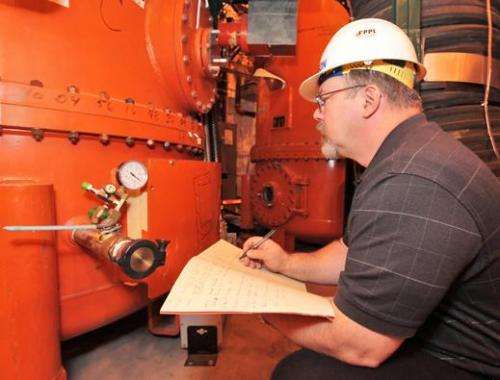Chasing down fugitive emissions

In an effort to respond to President Obama's call to reduce greenhouse gas emissions by 28 percent by the year 2020, researchers at the U.S. Department of Energy's Princeton Plasma Physics Laboratory (PPPL) have identified ways to cut emissions that will allow the facility to exceed that goal—a decade early.
Staff members at the laboratory, where scientists are finding ways to produce fusion energy, have trimmed the facility's greenhouse gas emissions by 32 percent, laboratory officials announced. Scrutinizing emissions with microscopic detail, researchers were able to pinpoint tiny leaks from a gas used to insulate electrical equipment.
By stopping these leaks from sulfur hexafluoride, also known as SF6, PPPL has environmentally achieved the equivalent of taking 315 commuters off the road for a year. The achievement represents the laboratory's largest success to date in reducing greenhouse gas emissions.
And that's cause for celebration during Earth Day observances, according to Robert Sheneman, deputy head of environment, safety and health/security at the laboratory. "PPPL has already achieved and surpassed the Federal greenhouse gas reduction targets," Sheneman said. "Our goal is to maintain and improve our performance."
PPPL uses sulfur hexafluoride to insulate high-voltage, electrical equipment such as power supplies and heating systems for fusion experiments. Sulfur hexafluoride, a greenhouse gas, is non-toxic, requires no permit to use, and presents no hazard to people when properly handled. "SF6 is intrinsic to high-voltage, electrical insulation at the National Spherical Torus Experiment (NSTX)," said Tim Stevenson, who headed PPPL's SF6 reduction project. NSTX is one of the largest fusion experiments in the nation.
"We looked at the systems and equipment valve by valve, fitting by fitting, to find chronic, low-level leaks," Stevenson said. "This was a major effort since it involved hundreds and hundreds of valves and fittings."
The electric power industry uses about two-thirds of all SF6 produced globally. Electricity powers all PPPL experiments. Since SF6 is used as an insulator for the neutral beam and radiofrequency high-voltage supplies, its emissions represent the single largest identified source of greenhouse gas emissions from laboratory operations. Neutral beams and radiofrequency power are used to heat plasma—a hot gas of charged particles and the fuel for fusion energy production—in NSTX.
Acute releases—the cause for most concern—are few at PPPL because systems are in place to reclaim and reuse SF6 during maintenance activities. "Most emissions here are chronic, low-level releases that occur as seepage through seals or valves in the equipment," Stevenson said. He compared them to the gradual air loss in bike tires.
Heightened awareness about the ozone depletion caused by SF6 emissions led the laboratory to address the reduction of these emissions.
Two years ago, Stevenson and his team developed and implemented a plan to reduce SF6 loss at PPPL. The objective: To reclaim, recover and reuse SF6 as much as possible.
"The first thing we did was to get a baseline," Stevenson said. The team looked at high-voltage areas at NSTX, including power supplies, high-voltage transmission lines, ion source enclosures and modulator regulators that act as fast switches for adjustable high-voltage pulses.
"SF6 leaks out due to pressure from the gas, especially in valves and fittings in the electrical equipment. We have to buy SF6 and replenish it in the power supplies and transmission lines," Stevenson said. "We check these areas every day and reclaim SF6. We know how much of the gas is here and how much we need to operate."
Members of the team surveyed all electrical equipment that uses SF6, as well as all SF6 containers. They took inventory of gas supplies and relevant equipment. They performed maintenance on all equipment, including valves and fittings. They redesigned fittings and seals. They also developed improved techniques with on-the-job training and revised procedures. The main areas for evaluation were NSTX heating systems that use neutral beams and radiofrequency.
The team repaired and replaced valves and fittings as needed. Members also instituted a practice of accurately weighing SF6 bottles for improved inventory calculations. "We fixed and tightened up everything," Stevenson said. "We performed maintenance on every thing large and small. We redesigned and repaired hard-to-get-to seals."
Presently, the team is installing a Volkswagen-sized, industrial-grade plastic bag at NSTX that will capture released SF6, which the original system did not account for or control. "Now this SF6 will be reclaimed and reused in the system," Stevenson said.
Additional reduction highlights at the laboratory include improving the energy efficiency of the lab's central plant boilers, expanding the use of biofuels in fleet vehicles, and a drop in employee commuter numbers. The drop in commuter numbers is attributed to an increased use of public transportation and carpooling.
Provided by Princeton Plasma Physics Laboratory













.jpg)





